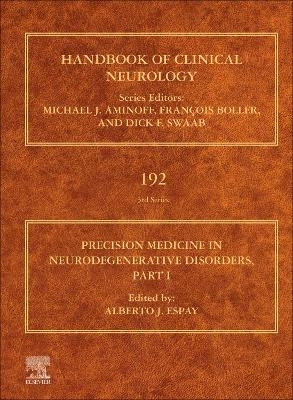
Precision Medicine in Neurodegenerative Disorders
Elsevier - Health Sciences Division (Verlag)
978-0-323-85538-9 (ISBN)
Specific chapters are dedicated to the promise of genetic subtypes and the lessons in disease modification offered by the fields of oncology and cystic fibrosis that can be adapted to the field of neurodegeneration. Matching a biology-correcting therapy with those biologically suitable to benefit from such therapy represents the vision and mission of precision medicine, the highest level of personalized medicine.
Dr. Alberto Espay is Professor and Endowed Chair of the James J. and Joan A. Gardner Center for Parkinson’s disease at the University of Cincinnati. He has published over 300 peer-reviewed research articles and 8 books, including Common Movement Disorders Pitfalls, which received the Highly Commended BMA Medical Book Award in 2013 and Brain Fables, the Hidden History of Neurodegenerative Diseases and a Blueprint to Conquer them, coauthored with Parkinson patient and advocate Benjamin Stecher, selected by the Association of American Publishers for the PROSE Award honoring the best scholarly work in Neuroscience published in 2020. He has served as Chair of the Movement Disorders Section of the American Academy of Neurology, Associate Editor of the Movement Disorders journal, and on the Executive Committee of the Parkinson Study Group. Among other honors, he has received the Cincinnati Business Courier’s Health Care Hero award, the Spanish Society of Neurology’s Cotzias award, and honorary membership in the Mexican Academy of Neurology. He currently serves as President-Elect of the Pan-American Section of the International Parkinson and Movement Disorders Society. With colleagues at the University of Cincinnati, he launched the first biomarker study of aging (CCBPstudy.com), designed to match people with neurodegenerative disorders to available therapies from which they are most biologically suitable to benefit, regardless of their clinical diagnoses.
Part 1 Conceptual Framework 1. The definition of precision medicine in neurodegenerative disorders and the one disease-many-diseases tension 2. Models of precision medicine for neurodegeneration 3. Pathology vs pathogenesis: Rationale and pitfalls in the clinicopathology model of neurodegeneration 4. Mixed pathology as a rule, not exception: Time to reconsider disease nosology? 5. Neurodegenerative disorders: From clinicopathology convergence to systems biology divergence 6. The emergence of genotypic divergence and future precision medicine applications 7. Lessons from other fields of medicine, Part 1: Breast cancer 8. Lessons from other fields of medicine, Part 2: Cystic fibrosis 9. Lessons learned from evolving frameworks in adult glioblastoma
Part 2 Pitfalls in Definitions, Cohorts, and Measures of Progression 10. Finding the falsification threshold of the toxic proteinopathy hypothesis in neurodegeneration 11. The theoretical problems of “prodrome and “phenoconversion in neurodegeneration 12. The dilemma between milestones of progression vs. clinical scales in Parkinson disease 13. Biomarkers of diagnosis, prognosis, pathogenesis, response to therapy: Convergence or divergence? Lessons from Alzheimer Disease and synucleinopathies 14. Challenges in the study of individuals at risk for Parkinson disease 15. The challenging quest of neuroimaging: From clinical to molecular-based subtyping of Parkinson disease and atypical parkinsonisms
| Erscheinungsdatum | 10.07.2023 |
|---|---|
| Reihe/Serie | Handbook of Clinical Neurology |
| Verlagsort | Philadelphia |
| Sprache | englisch |
| Maße | 195 x 260 mm |
| Themenwelt | Medizinische Fachgebiete ► Innere Medizin ► Endokrinologie |
| Medizin / Pharmazie ► Medizinische Fachgebiete ► Neurologie | |
| Studium ► 1. Studienabschnitt (Vorklinik) ► Biochemie / Molekularbiologie | |
| ISBN-10 | 0-323-85538-5 / 0323855385 |
| ISBN-13 | 978-0-323-85538-9 / 9780323855389 |
| Zustand | Neuware |
| Informationen gemäß Produktsicherheitsverordnung (GPSR) | |
| Haben Sie eine Frage zum Produkt? |
aus dem Bereich


